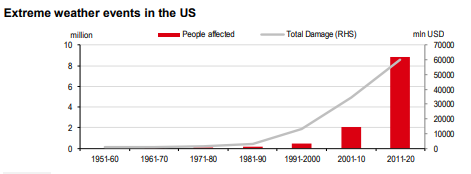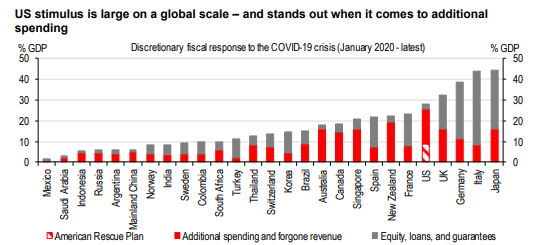US President Joe Biden may be receiving the praise for the slogan “Build Back Better”, a phrase UK Prime Minister Boris Johnson says Biden “nicked” from him. I can’t help but remember that the United Nations launched a campaign in 2004 called Build Back Better, to mitigate the increasing threat of natural disasters, within the Sendai Framework for Disaster Risk Reduction of 2015-2030.
Ok I lie, I didn’t remember that, I had to google it to make sure.
Whomever said it first, President Biden’s fiscal policy is now the most known iteration of Build Back Better, a policy of ~2 trillion USD worth of spending on infrastructure and other areas over the next 8 years (if he serves a second term).
The policy is expected to be financed through increased corporate taxes that would offset the cost, but over a longer time period of 15 years – which is an effective funding gap that will require the Treasury to tap bond markets in the interim period.
Today we look at the economic and ESG implications of the policy initiative, in particular to currency, equities, bonds and gold assets.
Policy Platform
I was lucky enough last week to attend a webinar involving Harvard professor emeritus Ken Froot, one of the USA’s great and influential minds in regard to financial market psychology, and market’s ability to discount information into prices.
Professor Froot brought up an interesting point – that the consensus expected Joe Biden to pick-up where former President Obama had left-off, which hasn’t been the case.
Instead, President Biden has used the platform that former president Trump established – an attempt to govern through a different style.
Afterall, Trump was elected to not only “drain the swamp” but also because he represented a non-establishment politician, and in a way, not a politician at all, more a pragmatist or businessman.
Utilising this, the Biden Administration is seeking to enact forceful policy that is popular and productive.
Policy Reform
The Administration has proposed a new package, called the American Jobs Plan, which would lift spending on infrastructure and other areas by about 1% of economic output (GDP) per year, while the American Rescue Plan was designed to have a bigger near-term economic impact to assist during the pandemic.
The American Jobs Plan is intended to lift productivity growth and economic output over the long run, forming the next phase of US policy experimentation.
Key Features
Some of the elements include (all figures in USD):
- 621b on transportation infrastructure, where 174b of this is for electric vehicles
- 100b for broadband infrastructure
- 213b for homes and commercial buildings
- 100b for public schools
- 400b for home care services and support for care workers
- 180b for R&D and technology investments
- 300b for manufacturing investment
- 100b for workforce development
Ways to Finance This (in USD):
- 1.3t by raising corporate taxes from 21 to 28%
- 750b by increasing global minimum tax for US multinationals
- 400b by eliminating deductions for foreign derived incomes
- 200b by enacting a 15% minimum tax on corporates’ “book” income
- With ~30b for taxing fossil fuels
Path to Implementation
The trillion-dollar questions are how congressional Democrats will seek to pass this policy, and if passed, how much of the above details will get through without revisions?
To start, Republican senators have indicated they are preparing a smaller counterproposal that focuses on a narrower set of infrastructure investment compared to the Biden Administration’s proposal, in a range of 600-800b USD.
This is already a promising start as there is bi-partisan support for the plan; the disagreements are the size, scope and scale.
President Biden is expected to provide an update on Wednesday (28th) to add clarity about whether bipartisan discussions have yielded any progress, or whether Democrats are likely to pursue enactment through budget reconciliation, where they would only require Democrat party support.
This is an interesting strategy as while the recent 1.9 trillion deal used budget reconciliation, it was considered part of the CY2020 budget, leaving this new deal to be passed under CY2021 budget.
In my view, President Biden will need to try and push this deal through relatively quickly, given Congress usually goes on recess during August, but also because he wants to unveil another package called the American Families Plan, afterwards.
ESG Impacts
Not only does the plan aim to build back the economy post pandemic, it also aims to make it greener and more resilient to climate-related risks.
The plan reflects targets for zero-carbon electricity by 2035 and net zero emissions by 2050.
A large portion of the funds will provide a network of over 500,000 electric vehicle charging stations, replacing over 50,000 diesel powered vehicles, and electrify the federal fleet and 20% of American school buses.
Railways, airports, waterways and ports will also be rebuilt to support decarbonisation, with roads and bridges modernised to be more resilient.
There is also suggestion to improve American power grids, lowering costs and improving air quality, a system that will utilise tax credits as a subsidy to more green behaviour.
Lastly as part of this program, they are seeking to build over 2 million affordable and sustainable homes, whilst also modernising public spaces, hospitals, schools and federal buildings.

FX Implications
I haven’t written about the trajectory of the USD since December so it’s worth revisiting.
The wider budget deficit implied by this proposed spending increases concerns about the structural integrity of the USD and the willingness of the market to continue to fund the twin current account and fiscal deficits of the US government.
Previous periods of above-average budget deficit spending have seen the USD weaken and so these periods are associated with USD weakness.
However, this may not be the case this time around, where this spending may be seen as productivity enhancing and beneficial economically, a positive to the USD structure.
The key will be the extent that fiscal policy feeds through to monetary policy and sees a less dovish Federal Reserve bank.
If the proposal is passed and deemed to upgrade the US economic outlook, the Fed may prove less dovish and making progress towards their goals of maximal employment and inflation averaging 2-3% p.a.
This additional stimulus would also be viewed as a risk-on event, supporting cyclical currencies such as the AUD, NZD, CAD and NOK, and putting pressure on safe-haven currencies such as the USD, JPY or CHF.
Bond Implications
I wrote about this recently on April 12th, musing my concerns regarding US government debt auctions, where the 1.2 trillion USD of spending from the previous 1.9trn American Rescue Plan has been causing some indigestion for bond markets to consume the increased supply of bonds.
In furtherance of this topic, US Treasury bonds tend to be a shock absorber when supply levels change.
Therefore, we can expect initial funding of the bill to use Treasury bond auctions, with subsequent increases in the US debt ceiling to accommodate.
The American Jobs Plan suggest a large headline for spending spread over the eight-year period, with tax increases funding about half the cost.
There may be fear that this increased deficit spending will continue to increase yet again with the American Families Plan (unannounced in detail yet), where the quantity of spending is unknown and will evolve over time.
We expect the trend of higher interest rates in 2021 to reassert itself, due to cyclically-driven spending and inflation fears, where in the longer-term, the secular trend of “lower for longer” interest rate policy re-emerges, where deficits return more to normal levels, but the sheer size of the debt issuance reduces future growth capacity.

Equity Implications
The impact of another round of fiscal stimulus has two major factors, where previous stimulus was not funded by tax reform.
This time around, the higher spending may lift economic growth through productivity enhancements, while the increased taxation may achieve the opposite – effectively a trade-off or a diminished return.
Given the increase in spending is spread out over eight years, it could be expected that it negatively impacts US equities in 2022 but will be positive thereafter.
Equities micro-strategy not being my forte, I’ve read Nomura and HSBC research that suggests that the increased taxation could reduce S&P500 net income margin by 0.60% and reduce Earnings Per Share (EPS) by 9USD, if even part of the tax plan is enacted.
I’m wary of these assumptions, however, as they project the effects of previous tax increases to model a future tax hike, where the productivity enhancements from R&D spending, technology uptake, electrical vehicle utilisation etc may have a greater effect, more than offsetting the cost of the tax.
Gold Implications
I’ll spend less time discussing gold as Max already published a recent note on April 22nd regarding the matter.
In summary and to further the discourse: gold takes much of its cue from monetary and fiscal policy, often in response to increasing government debt levels, which provides support for different stores of value, such as gold.
This is decreasingly the case due to the rise in popularity of alternatives, such as cryptocurrencies, or safe-haven currencies.
However, if debt levels increase at a greater rate than the economy is expanding, it may have an adverse impact on equity markets and the broader economy, which may lead greater allocation to gold as a store of value.
There are two main counters to this stance:
#1 Build Back Better may be positive for equities where productivity gains offset the tax increases associated, which would be structurally negative to the gold narrative;
#2 As Max points out in his note, gold has little utility and is only worth what people are willing to pay for it, where Millennial investors see less value in gold because currencies have not had links to gold within their lifetimes (since 1971).
In Closing
These policies seem a large and dominant factor this year, along with vaccine rollouts, where we’ll need to stay abreast of updates to gauge market sentiment and reaction, along with upside potential.
The next phase of the plan, the American Families Plan, is set to be announced in the coming weeks.
The views expressed in this article are the views of the stated author as at the date published and are subject to change based on markets and other conditions. Past performance is not a reliable indicator of future performance. Mason Stevens is only providing general advice in providing this information. You should consider this information, along with all your other investments and strategies when assessing the appropriateness of the information to your individual circumstances. Mason Stevens and its associates and their respective directors and other staff each declare that they may hold interests in securities and/or earn fees or other benefits from transactions arising as a result of information contained in this article.



